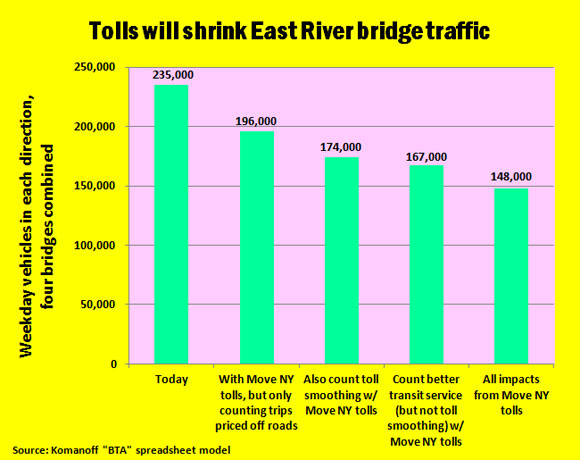With crowding on the Brooklyn Bridge walking and biking path in a state of near constant low-level emergency, this week NYC DOT announced a feasibility study of widening the bridge’s promenade. A path with sufficient space for the thousands of commuters, exercisers, and tourists who walk and bike across the bridge each day would be an immensely valuable improvement. But what if the same benefits could be derived at less cost by claiming space on the Brooklyn Bridge roadway?
At the heart of the issue is space. If motorists see a big new bike lane on the bridge while they stew in rush-hour traffic, the configuration might not last. Could tolls liberate enough space to turn over a Brooklyn Bridge car lane to bikes?
The answer depends on the toll levels as well as on assumptions about traffic redistribution from equalizing tolls with other crossings nearby, and the degree to which investing toll revenues would lead to improved transit service. Let’s look at some numbers.
The number of motor vehicles on the East River bridges averaged 235,000 per day in each direction in 2014, the last year for which data is available. (It makes more sense to look at the four East River bridges as one entity since they likely would be tolled together.)
Tolling the bridges would reduce that figure in three ways: by pricing some vehicle trips off the roads; by redistributing some trips from the free bridges to the Brooklyn Battery and Queens Midtown Tunnels and the Triborough Bridge, which already have tolls; and by expediting transit improvements that would attract some trips in and out of Manhattan that are now made by car.
As longtime readers know, I maintain an Excel model of NYC travel that estimates these kinds of impacts. The results are shown in the graphic, assuming implementation of tolls in the Move NY Plan. Here’s a breakout.
- Simply tolling the East River bridges (and all Manhattan highways and streets where they cross 60th Street) at the same rate as the East River tunnels -- $5.54 in each direction, $8.00 if the vehicle lacks E-ZPass -- will cut current daily throughput by 39,000 vehicles a day. (The shrinkage would be greater but for the “rebound” effect by which improved travel speeds re-attract some trips that would be priced off the roads; this effect is reflected in all of the figures here.)
- There’s also toll “smoothing,” whereby some trips now taken on a free bridge gravitate to the tunnels and the Triborough, once the tolls are equalized. That knocks another 22,000 daily trips in each direction from the bridges total, on top of the 39,000 trips removed due to the toll’s direct disincentive.
- The Move NY Plan allocates the lion’s share of its net revenues to modernizing transit nuts and bolts (like signals) in ways that cut crowding and speed service and thus lure other car trips to the subways. This “attraction,” which is separate from both the toll disincentive and toll smoothing, is strong enough to cut bridge traffic by 29,000 trips a day.
The combined impact of the toll disincentive, toll smoothing and better transit is a reduction of 87,000 vehicle trips a day in each direction. (That figure is slightly less than the 90,000 sum of the separate factors, since my model eliminates double-counting.) However, the better-transit component requires capital investment that will take years to bear fruit. That leaves a projected reduction in total East River bridge traffic of around 61,000 vehicles per direction each day, or just over a quarter of the current 235,000.
With a 25 percent cut in traffic, the City could easily convert one though not two of the Brooklyn Bridge’s six total car lanes to bikes, making that car lane a two-way bike lane. NYC DOT might look at making another car lane bi-directional according to time of day as a way of harmonizing capacity with demand.
Yes, there would be engineering challenges, but the results here suggest that East River bridge tolls -- a key ingredient of the Move NY plan -- would make a bike lane on the Brooklyn Bridge roadway more plausible. Though enacting tolls is Albany’s responsibility, the city officials and advocates focused on the bridge path should consider how tolls can factor into the eventual solution.






